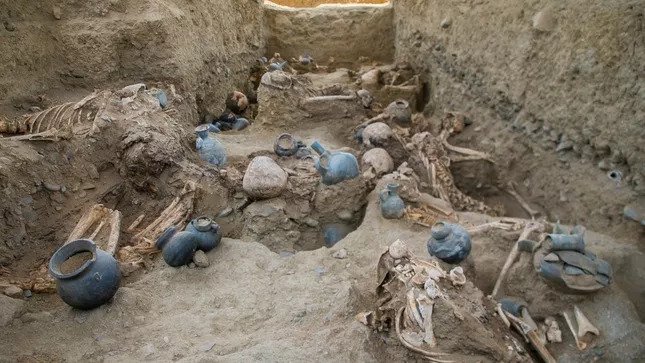15th-century Chan Chan mass grave discovered in Peru
A mass grave of 25 to 30 skeletons has been unearthed in the ancient Peruvian city of Chan Chan, which archaeologists believe is the resting place of the society’s elite members.
The remains were discovered in a small space measuring just 107 square feet, roughly 10 feet long and 10 feet wide, located inside what was once the capital of the Chimú empire that reached its height in the 15th century before falling to the Incas in 1470 AD.
Archaeologist Jorge Menese told Reuters that although this ancient society is known for human sacrifices, there is no evidence suggesting that this occurred at the site.
However, researchers plan to conduct tests in the future to determine each of the individual’s causes of death.
The Chimú were a pre-Incan culture that emerged out of the remnants of the Moche culture along the coast of Peru in 900 AD.
These ancient people lived in a strip of desert, 20 to 100 miles, in the South American country, between the Pacific Ocean and the Andes.
It’s thought that the Chimú culture peaked in the first half of the 14th century, developing a complex civilization with different levels of social hierarchy.
Most of the mass graves found in and around the ancient city were a result of human sacrifice, but Menese said the position of these 25 to 30 skeletons suggest they were buried shortly after the person had died.

Archaeologist Sinthya Cueva said in a video shot at the site that although the remains are of men, women and children, most are women no older than 30.
The Chimú empire is famous for human sacrifices, specifically one uncovered in 2019 that is the largest the world has ever seen.
More than 140 children, along with llamas, were found slaughtered in what is thought to be a mass sacrifice to appease the gods of a now extinct religion.
Many of the children and juvenile animals had their hearts cut out during the grisly ritual.
The children ranged in age from five to 14 years old.

It is thought a huge El Niño caused major flooding and storms which triggered the bloody sacrifice.
Analysis of the remains of more than 200 juvenile llamas and humans dates it to approximately 1450, during the peak of the Chimú civilization in northern coastal Peru.
Study author John Verano, professor of anthropology at Tulane University, said: ‘This site opens a new chapter on the practice of child sacrifice in the ancient world.
‘This archaeological discovery was a surprise to all of us – we had not seen anything like this before, and there was no suggestion from ethnohistoric sources or historic accounts of child or camelid sacrifices being made on such a scale in northern coastal Peru.
‘We were fortunate to be able to completely excavate the site and to have a multidisciplinary field and laboratory team to do the excavation and preliminary analysis of the material.’





